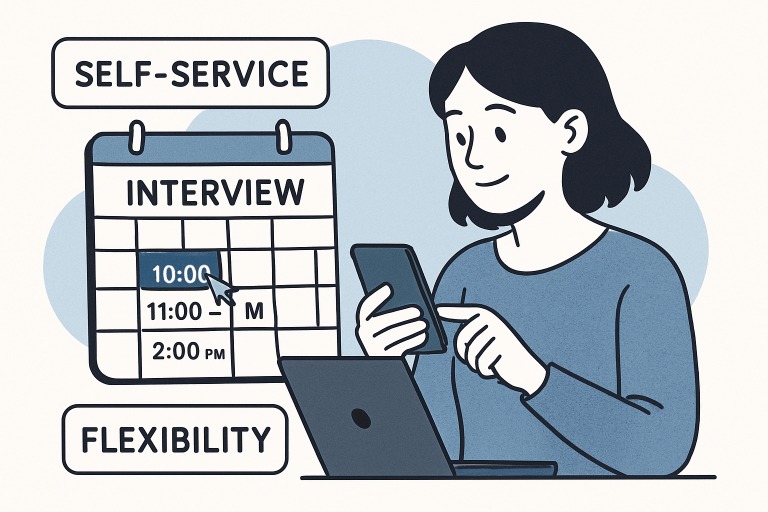Introduction
The ability to deliver a great candidate experience is a defining factor for organizations looking to attract and hire top talent in a highly competitive job market. One powerful strategy that hiring teams adopt is candidate-led scheduling, which allows applicants to take the reins in selecting interview times that work for them. It empowers candidates and injects transparency and flexibility into what is often a stressful process. For recruiting professionals wanting to learn more about the evolution of interview scheduling, understanding this shift is key to standing out in talent acquisition. With candidate expectations rising and interview logistics increasingly complex, empowering candidates to determine their interview times can streamline recruitment, reduce administrative burdens, and create lasting positive impressions.
Benefits of Candidate-Led Scheduling
- Empowerment: When candidates can choose their interview slots, it signals respect for their time and current obligations, making them feel valued from the start.
- Efficiency: This approach can help eliminate time-consuming back-and-forth, freeing recruiting teams to focus on more strategic efforts.
- Flexibility: It becomes far simpler to accommodate the diverse schedules of candidates, including passive job seekers and those who are currently employed.
According to a recent Greenhouse article, automation in candidate scheduling not only shortens the time-to-hire but is now becoming expected by job seekers.
Implementing Candidate-Led Scheduling
To integrate candidate-led scheduling into your recruitment process, several essential steps must be followed:
- Choose the Right Tools: It is crucial to select scheduling software that integrates seamlessly with your applicant tracking and calendar systems. The interface should be intuitive for both recruiters and candidates.
- Set Clear Parameters: Pre-define available interview slots based on the hiring manager and team members’ availability. Clearly communicate constraints, such as blackout dates or required interview durations.
- Communicate Clearly: Ensure candidates receive detailed, step-by-step instructions on accessing and using the scheduling tool. Clarity removes friction and reduces the risk of missed interviews or misunderstandings.
This shift modernizes the candidate experience and makes recruitment teams more agile and responsive in a fast-moving labor market.
Leveraging Technology for Seamless Scheduling
Intelligent scheduling platforms are changing how organizations approach candidate interaction. These tools provide real-time visibility into interviewer availability, allow for automatic adjustments in response to calendar changes, and empower candidates to make choices that work for them.
As a Forrester Consulting study highlighted, teams that utilize such technology experience a 26% reduction in their overall recruiting cycle. This reduction translates to less resource expenditure for recruiters and a consistently positive candidate experience. More insights into scheduling automation’s impact can be found on Greenhouse, highlighting industry-wide adoption of these practices.
Ensuring Consistent Communication
Even the most advanced scheduling system is only as effective as the communication surrounding it. Automated confirmations and reminders, paired with personalized touchpoints from your recruiting team, reduce no-shows and ease candidate anxiety. According to the Candidate Experience Institute, continuous updates and open dialogue prevent misunderstandings and leave candidates feeling respected and well-informed throughout the process.
To avoid frustration, respond to candidate outreach in a timely manner and keep applicants informed of their status and next steps at all times.
Personalizing the Candidate Experience
Personalization remains a differentiating factor in great recruitment. Address candidates by name, reference their specific roles or interests in your communications, and offer options relevant to their schedules. This tailored approach signals care, attention to detail, and a commitment to each individual’s journey.
Personalized messaging builds goodwill and contributes directly to your employer brand — a critical factor cited by Glassdoor as influencing over 75% of job seekers’ decisions to apply for or accept a job offer.
Monitoring and Improving the Process
Gathering feedback consistently from candidates after their scheduling experience is essential for evidence-based improvement. Use quick pulse surveys or post-interview forms to understand what worked well and where friction occurred. Analyze this data to tweak systems, address sticking points, and iterate on your process so that each candidate cycle is smoother than the last.
Continually refining your candidate-led scheduling process ensures it remains efficient, empathetic, and reflects your company’s dedication to candidate experience.
Final Thoughts
Candidate-led scheduling represents a critical advancement in recruitment best practices. With the right blend of technology, communication, and personalization, organizations can offer a streamlined, empowering, and engaging hiring process that attracts and retains top talent. By putting the candidate in control, recruiters signal respect and innovation—qualities that resonate both during the process and long after an offer is made.
